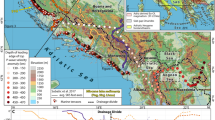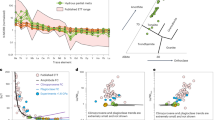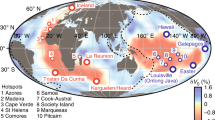Abstract
The global ridge system is dominated by oceanic rises reflecting large variations in axial depth associated with mantle hotspots. The little-studied Marion Rise is as large as the Icelandic Rise, considering both length and depth, but has an axial rift (rather than a high) nearly its entire length. Uniquely along the Southwest Indian Ridge systematic sampling allows direct examination of crustal architecture over its full length. Here we show that, unlike the Icelandic Rise, peridotites are extensively exposed high on the rise, revealing that the crust is generally thin, and often missing, over a rifted rise. Therefore the Marion Rise must be largely an isostatic response to ancient melting events that created low-density depleted mantle beneath the Southwest Indian Ridge rather than thickened crust or a large thermal anomaly. The origin of this depleted mantle is probably the mantle emplaced into the African asthenosphere during the Karoo and Madagascar flood basalt events.
This is a preview of subscription content, access via your institution
Access options
Subscribe to this journal
Receive 51 print issues and online access
$199.00 per year
only $3.90 per issue
Buy this article
- Purchase on Springer Link
- Instant access to full article PDF
Prices may be subject to local taxes which are calculated during checkout




Similar content being viewed by others
References
Morgan, W. J. Deep mantle convection plumes and plate motions. Am. Assoc. Petrol. Geol. Bull. 56, 203–213 (1972)
Kincaid, C., Schilling, J.-G. & Gable, C. The dynamics of off-axis plume-ridge interaction in the uppermost mantle. Earth Planet. Sci. Lett. 137, 29–43 (1996)
Weir, R. W. et al. Crustal structure of the northern Reykjanes Ridge and Reykjanes Peninsula, southwest Iceland. J. Geophys. Res. 106, 6347–6368 (2001)
Ito, G. & Behn, M. D. Magmatic and tectonic extension at mid-ocean ridges: 2. Origin of axial morphology. Geochem. Geophys. Geosyst. 9 Q09O12 http://dx.doi.org/10.1029/2008GC001970 (2008)
Wang, T., Lin, J., Tucholke, B. & Chen, Y. J. Crustal thickness anomalies in the North Atlantic Ocean basin from gravity analysis. Geochem. Geophys. Geosyst. 12 Q0AE02 http://dx.doi.org/10.1029/2010GC003402 (2011)
Canales, J. P., Ito, G., Detrick, R. S. & Sinton, J. Crustal thickness along the western Galapagos Spreading Center and the compensation of the Galapagos hotspot swell. Earth Planet. Sci. Lett. 203 311–327 http://dx.doi.org/10.1016/S0012-821X(02)00843-9 (2002)
Cannat, M., Rommevaux-Jestin, C., Sauter, D., Deplus, C. & Mendel, V. Formation of the axial relief at the very slow spreading Southwest Indian Ridge (49° to 69°E). J. Geophys. Res. 104, 22825–22843 (1999)
Dick, H. J. B., Fisher, R. L. & Bryan, W. B. Mineralogic variability of the uppermost mantle along mid-ocean ridges. Earth Planet. Sci. Lett. 69, 88–106 (1984)
Georgen, J. E., Lin, J. & Dick, H. J. B. Models of mantle upwelling beneath the Southwest Indian Ridge: the effects of ridge-transform geometry on magma supply at an ultra-slow spreading ridge. Eos 79, abstr. 854 (1998)
Niu, Y. & O'Hara, M. J. Global correlations of ocean ridge basalt chemistry with axial depth: a new perspective. J. Petrol. 49, 633–664 (2008)
O'Hara, M. J. Is there an Icelandic mantle plume? Nature 253, 708–710 (1975)
Presnall, D. C. & Helsley, C. E. Diapirism of depleted peridotite—a model for the origin of hot spots. Phys. Earth Planet. Inter. 29, 148–160 (1982)
Muller, M. R., Minshull, T. A. & White, R. S. Segmentation and melt supply at the Southwest Indian Ridge. Geology 27, 867–870 (1999)
Zhang, T., Lin, J. & Gao, J. Y. Interactions between hotspots and the Southwest Indian Ridge during the last 90 Ma: implications on the formation of oceanic plateaus and intra-plate seamounts. Sci. China Earth Sci. 54 http://dx.doi.org/10.1007/s11430-011-4219-9 (2011)
Muller, M. R., Robinson, C. J., Minshull, T. A., White, R. S. & Bickle, M. J. Thin crust beneath ocean drilling program borehole 735B at the Southwest Indian Ridge? Earth Planet. Sci. Lett. 148, 93–107 (1997)
Cannat, M. et al. Modes of seafloor generation at a melt-poor ultraslow-spreading ridge. Geology 34, 605–608 (2006)
Jokat, W. et al. Geophysical evidence for reduced melt production on the super-slow Gakkel Ridge (Arctic Ocean). Nature 423, 962–965 (2003)
Dick, H. J. B. et al. A long in-situ section of the lower ocean crust: results of ODP Leg 176 drilling at the Southwest Indian Ridge. Earth Planet. Sci. 179, 31–51 (2000)
Dick, H. J. B., Tivey, M. A. & Tucholke, B. E. Plutonic foundation of a slow-spreading ridge segment: oceanic core complex at Kane Megamullion, 23°30'N, 45°20'W. Geochem. Geophys. Geosyst. 9 44 http://dx.doi.org/10.1029/2007GC001645 (2008)
Klein, E. M. & Langmuir, C. H. Global correlations of ocean ridge basalt chemistry with axial depth and crustal thickness. J. Geophys. Res. 92, 8089–8115 (1987)
Patriat, P. & Segoufin, J. Reconstruction of the Central Indian Ocean. Tectonophysics 155, 211–234 (1988)
Sclater, J. G., Grindlay, N. R., Madsen, J. A. & Rommevaux-Jestin, C. Tectonic interpretation of the Andrew Bain transform fault: Southwest Indian Ocean. Geochem. Geophys. Geosyst. 6 http://dx.doi.org/10.1029/2005GC000951 (2005)
Duncan, R. A. Hot spots in the southern oceans—an absolute frame of reference for the motion of the Gondwana continents. Tectonophysics 74, 29–42 (1981)
Georgen, J. E., Lin, J. & Dick, H. J. B. Evidence from gravity anomalies for interactions of the Marion and Bouvet hotspots with the Southwest Indian Ridge: effect of transform offsets. Earth Planet. Sci. Lett. 187, 283–300 (2001)
Dick, H. J. B., Lin, J. & Schouten, H. An ultraslow-spreading class of ocean ridge. Nature 426, 405–412 (2003)
Fisher, R. L. & Dick, H. J. B. Natland, J. & Meyer, P. S. Mafic/ultramafic suites of the slowly spreading Southwest Indian Ridge: PROTEA Exploration of the Antarctic Plate Boundary, 24°E - 47°E. Ophioliti 11, 147–178 (1986)
Le Roex, A. P., Dick, H. J. B. & Fisher, R. L. Petrology and geochemistry of MORB from 25°E to 46°E along the Southwest Indian Ridge: evidence for contrasting styles of mantle enrichment. J. Petrol. 30, 947–986 (1989)
Dick, H. J. et al. How variable slow-spread ocean crust. Eos 84, abstr. #V22F-01. (2003)
Dick, H. J. B. in Magmatism in the Ocean Basins (eds Saunders, A. D. & Norry, M. J. ) 71–105 (Geological Society Special Publication No. 42, 1989)
Jaroslow, G. E., Hirth, G. & Dick, H. J. B. Abyssal peridotite mylonites: implications for grain-size sensitive flow and strain localization in the oceanic lithosphere. Tectonophysics 256, 17–37 (1996)
Ildefonse, B. et al. Oceanic core complexes and crustal accretion at slow-spreading ridges. Geology 35, 623–626 (2007)
Hellebrand, E., Snow, J. E., Dick, H. J. B. & Hofmann, H. Coupled major and trace-element indicators in mid-ocean ridge peridotites. Nature 410, 677–681 (2001)
Sun, S.-s. Chemical composition and origin of the Earth's primitive mantle. Geochim. Cosmochim. Acta 46, 179–192 (1982)
Dick, H. J., Tivey, M. A., Tucholke, B. E. & Cheadle, M. J. The plutonic foundation of a MAR ridge spreading segment: the Kane Oceanic Core Complex. Eos 86, abstr. T33G–02. (2005)
Xu, M., Canales, J. P., Tucholke, B. E. & DuBois, D. L. Heterogeneous seismic velocity structure of the upper lithosphere at Kane oceanic core complex, Mid-Atlantic Ridge. Geochem. Geophys. Geosyst. 10 http://dx.doi.org/10.1029/2009GC002586 (2009)
Kelemen, P. B. et al. Drilling mantle peridotite along the Mid-Atlantic Ridge from 14° to 16°N. Proc. ODP Init. Rep. 209, (Ocean Drilling Program, 2004)
Cannat, M. et al. Ultramafic and gabbroic exposures at the Mid-Atlantic Ridge: geologic mapping in the 15°N region. Tectonophysics 279, 193–213 (1997)
Blackman, D. K. et al. Proceedings of the Integrated ODP 304/305 (Integrated Ocean Drilling Program Management International, http://dx.doi.org/10.2204/iodp.proc.304305.2006 (2006)
Morishita, T. et al. Igneous, alteration and exhumation processes recorded in abyssal peridotites and related fault rocks from an oceanic core complex along the Central Indian Ridge. J. Petrol. 50, 1299–1325 (2009)
Teagle, D. A. et al. Drilling a complete in situ section of upper oceanic crust formed at a superfast spreading rate: hole 1256D. Eos 87 (52), abstr. B31B–1090. (2006)
Cannat, M., Sauter, D., Escartin, J., Lavier, L. & Picazo, S. Oceanic corrugated surfaces and the strength of the axial lithosphere at slow spreading ridges. Earth Planet. Sci. Lett. 288, 174–183 (2009)
Jordan, T. H. in The Mantle Sample: Inclusions in Kimberlites and Other Volcanics (Proceedings of the Second International Kimberlite Conference) (eds Boyd, F. R. & Meyer, H. O. A. ) Vol. 2, 1–14 (American Geophysical Union, 1979)
Cadio, C., Ballmer, M. D., Panet, I., Diament, M. & Ribe, N. New constraints on the origin of the Hawaiian swell from wavelet analysis of the geoid to topography ratio. Earth Planet. Sci. Lett. 359–360 40–54 http://dx.doi.org/10.1016/j.epsl.2012.10.006 (2012)
Ito, G., Shen, Y., Hirth, G. & Wolfe, C. J. Mantle flow, melting, and dehydration of the Iceland mantle plume. Earth Planet. Sci. Lett. 165, 81–96 (1999)
Detrick, R. S., Needham, H. D. & Renard, V. Gravity anomalies and crustal thickness variations along the Mid-Atlantic Ridge between 33°N and 40°N. J. Geophys. Res. 100, 3767–3787 (1995)
Canales, J. P., Detrick, R. S., Lin, J., Collins, J. A. & Toomey, D. R. Crustal and upper mantle seismic structure beneath the rift mountains and across a non-transform offset at the Mid-Atlantic Ridge. J. Geophys. Res. 105, 2699–2720 (2000)
Karson, J. A. et al. Detachment shear zone of the Atlantis Massif core complex, Mid-Atlantic Ridge, 30°N. Geochem. Geophys. Geosyst. 7,. Q06016 http://dx.doi.org/10.1029/2005GC001109 (2006)
Georgen, J. E. & Lin, J. Plume-transform interactions at ultra-slow spreading rates: Implications for the Southwest Indian Ridge. Geochem. Geophys. Geosyst. 4 (9). 9106 http://dx.doi.org/10.1029/2003GC000542 (2003)
Dick, H. J., Lin, J., Michael, P. J., Schouten, H. & Snow, J. E. Ultra-slow-spreading—a new class of ocean ridge. Eos 83, abstr. T52E-05. (2002)
Dick, H. J. B., Arai, S., Hirth, G. & John, B. J. KROO-06 Scientific Party. A subhorizontal cross-section through the crust mantle boundary at the SW Indian Ridge. Geophys. Res. Abstr. 3, 794 (2001)
Bougault, H. & Cande, S. C. 1. Background, objectives, and summary of principal results: Deep Sea Drilling Sites 556-564. Init. Rep. DSDP 82, 5–16 (1985)
Aumento, F. & Melson, W. G. Initial Reports of the Deep Sea Drilling Project Vol. 37, 1008 (US Government Printing Office, 1977)
Dick, H. J. B., Bryan, W. B. & Thompson, G. Low-angle faulting and steady-state emplacement of plutonic rocks at ridge-transform intersections. Eos 62, 406 (1981)
Tucholke, B. E. & Lin, J. A geological model for the structure of ridge segments in slow spreading ocean crust. J. Geophys. Res. 99, 11937–11958 (1994)
Cann, J. R. et al. Corrugated slip surfaces formed at ridge–transform intersections on the Mid-Atlantic Ridge. Nature 385, 329–332 (1997)
Smith, D. K., Cann, J. R. & Escartin, J. Widespread active detachment faulting and core complex formation near 13°N on the Mid-Atlantic Ridge. Nature 442, 440–443 (2006)
Escartín, J. et al. Central role of detachment faults in accretion of slow-spreading oceanic lithosphere. Nature 455, 790–794 (2008)
Michael, P. J. et al. Magmatic and amagmatic seafloor spreading at the slowest mid-ocean ridge: Gakkel Ridge, Arctic Ocean. Nature 423, 956–961 (2003)
Sauter, D. et al. Focused magmatism versus amagmatic spreading along the ultra-slow spreading Southwest Indian Ridge: evidence from TOBI side scan sonar imagery. Geochem. Geophys. Geosyst. 5 http://dx.doi.org/10.1029/2004GC000738 (2004)
MacLeod, C. J. et al. Life cycle of oceanic core complexes. Earth Planet. Sci. Lett. 287, 333–344 (2009)
Schroeder, T. et al. Nonvolcanic seafloor spreading and corner-flow rotation accommodated by extensional faulting at 15 N on the Mid-Atlantic Ridge: a structural synthesis of ODP Leg 209. Geochem. Geophys. Geosyst. 8 http://dx.doi.org/10.1029/2006GC001567 (2007)
Standish, J. J., Dick, H. J. B., Michael, P. J., Melson, W. G. & O'Hearn, T. MORB generation beneath the ultraslow-spreading Southwest Indian Ridge (9°-25°E): major element chemistry and the importance of process versus source. Geochem. Geophys. Geosyst. 9 Q05004 http://dx.doi.org/10.1029/2008GC001959 (2008)
Acknowledgements
This work was supported by the Chinese National Key Basic Research Program (2012CB417300), China Ocean Mineral Resources Research and Development Association, and the US National Science Foundation (grant OCE-0526905). We thank the crew and scientists of RV Dayang Yihao Cruise 21. M. Sulanowska provided technical support. Z. Chen and Y. Liu analysed chrome spinels for us at the Guangzhou Institute of Geochemistry, Chinese Academy of Sciences. A glass sample from 53° E was analysed by F. Ji at the State Key Laboratory for Mineral Deposits Research, Nanjing University. We thank the Core and Rock Storage Facility of the Woods Hole Oceanographic Institution for curatorial support and access to samples. D. Sauter, R. Fisher and E. Bonatti provided additional unpublished sample descriptions and locations for the eastern and western SWIR. A review by Y. Niu encouraged us to provide more appropriate measurements of ridge depth and directed us to several important papers, greatly benefiting the manuscript and its conclusions.
Author information
Authors and Affiliations
Contributions
This article represents the first report of results of a survey during Cruise 21 Leg 5 of the RV Dayang Yihao directed by H.Z., who also had additional analytical work done at his institution. H.J.B.D. collected the bulk of the sample data over a period of 35 years. Both authors interpreted the results, with H.J.B.D. primarily responsible for the written text.
Corresponding authors
Ethics declarations
Competing interests
The authors declare no competing financial interests.
Supplementary information
Supplementary Information
This file contains Supplementary Figures 1-3 and Supplementary Tables 2-3 (see separate excel file for Supplementary Table 1). (PDF 8165 kb)
Supplementary Tables
This file contains Supplementary Table 1. (XLS 238 kb)
Rights and permissions
About this article
Cite this article
Zhou, H., Dick, H. Thin crust as evidence for depleted mantle supporting the Marion Rise. Nature 494, 195–200 (2013). https://doi.org/10.1038/nature11842
Received:
Accepted:
Published:
Issue Date:
DOI: https://doi.org/10.1038/nature11842
This article is cited by
-
Magmatic processes within the plumbing system of the ultraslow-spreading southwest Indian ridge: constraints from olivine, plagioclase and melt inclusions
Contributions to Mineralogy and Petrology (2024)
-
Sulfide metallogenic model for the ultraslow-spreading Southwest Indian Ridge
Science China Earth Sciences (2023)
-
Peridotites with back-arc basin affinity exposed at the southwestern tip of the Mariana forearc
Progress in Earth and Planetary Science (2022)
-
Characteristics of rare earth elements in the surface sediments of Southwest Indian Ridge: implication of grain size for the identification of hydrothermal activity
Geo-Marine Letters (2022)
-
Pervasive detachment faults within the slow spreading oceanic crust at the poorly coupled Antilles subduction zone
Communications Earth & Environment (2021)
Comments
By submitting a comment you agree to abide by our Terms and Community Guidelines. If you find something abusive or that does not comply with our terms or guidelines please flag it as inappropriate.



